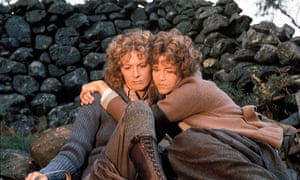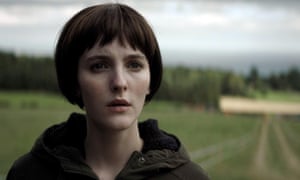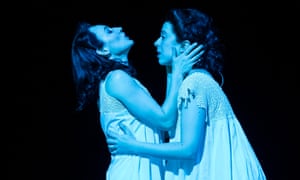Undercover heiress: the Chicago meat-packing scion who outfoxed the Gestapo
She took tea with Sigmund Freud, had an affair with Stephen Spender, risked her life in the Austrian resistance – and inspired an Oscar-winning film. Can a new show about Muriel Gardiner capture her extraordinary life?

In 1978 the novelist Mary McCarthy ignited one of the fiercest feuds in literary history by claiming on a TV chatshow that every word of Lillian Hellman’s memoir was a lie, “including ‘and’ and ‘the’”. Hellman, a screenwriter and playwright, immediately launched a $2.5m defamation suit. McCarthy’s charge centred on Hellman’s claim to have been close friends with a heroic American member of the resistance in 1930s Vienna. So captivating was the story of their relationship that it had been made into an Oscar-winning film, starring Jane Fonda as Hellman and Vanessa Redgrave as the eponymous Julia.
At her home in the US, psychoanalyst and psychiatrist Muriel Gardiner had become aware of the memoir, Pentimento, when it was published in 1973, after friends began to call, suggesting that Julia must be her. “I have never met Lillian Hellman,” she later wrote, “but I read the story and was indeed struck by the many similarities between my life and her heroine’s.” When the film came out, the calls became more regular. A consultation with the director of Austria’s resistance archives confirmed that there had only ever been one American heiress in the country’s anti-Nazi underground: Muriel Gardiner, whose code name was Mary.
To throw the Gestapo off the scent, Gardiner had occasionally adopted other aliases – Erika, Elizabeth, Gerda – but Julia was not among them. Still, her story is so extraordinary that one could hardly blame Hellman for becoming entranced by it. In the mid-1920s, this globetrotting Chicago heiress wrote to Sigmund Freud asking him to take her on for analysis in Vienna. He wrote back regretting that he was too busy, but recommended an American colleague also based in the city.
Gardiner moved to Vienna and attended the Wednesday Psychological Society, which Freud had founded in 1902. She also took Russian lessons from one of his most famous patients, Sergei Pankejeff or The Wolf Man, so-called because he was haunted by dreams of white wolves perched in a tree, which were eventually traced to a childhood event: him witnessing his parents having sex.
Gardiner only once met the father of psychoanalysis for tea in his garden, but befriended his daughter, Anna, and would later help her to finance London’s Freud Museum, in the spacious house where he lived after fleeing Austria in 1938. An exhibition celebrating her life opens there this month. It will include paintings Gardiner bought from The Wolf Man to keep him from penury, as well as his death mask, but it also contains documents attesting to her cloak and dagger life in the Austrian underground.
Among the guest speakers will be Vanessa Redgrave, who never met Gardiner but incorporated her story into a play, Vienna 1934–Munich 1938, about socialist resistance to the Nazis. She emphasises the relevance of Gardiner’s story today. “She saved refugees: in her time, they were Jewish; these days, they are mostly Muslim. We haven’t got a Nazi machine, but we have governments here and in Europe behaving terribly.”
As fascism gathered force in Austria in the 1930s, Gardiner provided a safe house for dissidents, circulating money and intelligence, while smuggling people out and identity papers in. She was on the analyst’s couch when she heard troops open fire on a workers’ colony in 1934, signalling the end of the democratic government. On one occasion, she was marched off a train at the Czech/Austrian border with five passports taped to her body, only escaping because she wasn’t among the one in three women who were strip-searched.
“Prudence […] would have advised that she follow the example of the many other Americans who did not hesitate to return to their native country,” wrote Anna Freud years later in an introduction to Gardiner’s autobiography, Code Name Mary, which is being republished to coincide with the exhibition. “Those of us who, at this period, were forced to share the experience of lying sleepless in bed in the early morning hours, waiting for the dreaded knock of the Gestapo at our doors, find it difficult, even impossible, to imagine that anybody could choose voluntarily to face the same anxieties.”
Gardiner started life as Helen Muriel Morris in 1901, the youngest of four children born into an alliance of two fortunes founded on meat-packing in Chicago. By 12, she had her own allowance, and by 21 an independent income. But she was uncomfortable about her wealth. In a 1987 documentary, The Real Julia, schoolfriends recall a political firebrand in the making, who led successful protests against petty regulations.
After graduating with a degree in literature and history from a liberal arts college near Boston , she took herself off to teach in Rome, where she had her first brush with fascism in 1922, when Mussolini’s forces marched on the city. “I thought it rather a lark to be halted at the Porta Flaminia,” she wrote. She went to Oxford, which she found “rather bleak, rigid and unfriendly to women students”. Her thesis on Mary Shelley was failed because she refused to condemn suicide before an examination panel of “two clergymen and a woman of rigid mind”.
Gardiner arrived in Vienna in 1926 to begin psychoanalysis, setting herself up in an apartment and marrying an English artist, Julian Gardiner. The marriage lasted long enough to produce a daughter, Connie, but she was a free spirit and before long she was off. During a seaside holiday in 1934, in what is now Croatia, she met the poet Stephen Spender. He was with his lover Tony Hyndman, who was posing as his secretary. Gardiner became the poet’s first female lover, later writing in her memoir: “Stephen was totally open about the fact that his previous relationships had only been with men.” In a letter to Christopher Isherwood, Spender said: “I find boys much more attractive […] but actually I find the actual sexual act with women more satisfactory, more terrible, more disgusting and, in fact, more everything.”
In her memoir, Gardiner seems like a Henry James character – the wealthy new world beauty on the loose in old Europe – who has wandered into a John le Carré novel. With a regular supply of foreign currency smuggled in from the Netherlands, she was ripe for exploitation (a mysterious stranger, who pushed her into doing a dangerous handover, later turned out to have been the spy Kim Philby). But she was also a brilliant networker, who obtained British citizenship for her daughter’s Jewish nanny by paying Hyndman to marry her, and who lined up an international array of rich friends to sign affidavits guaranteeing to support refugees she had helped to escape.
Gardiner later fell in love with and married the leader of the Austrian socialist resistance, Joseph Buttinger, staying on in Vienna to continue her rescue work – and finish her medical degree – after Germany annexed Austria and Buttinger and his comrades fled to Paris to run the opposition from exile. “That was when my real work began,” she later said. As war was declared in September 1939, the couple caught the last American boat out of France.
To put her fortune to charitable use Gardiner set up the New-Land Foundation, which to this day campaigns for arms control and the protection of the environment. She worked as a psychiatrist and psychoanalyst, and would send food parcels to Europe to help those left destitute by the war. Among the documents in the exhibition will be touching letters thanking her for gifts of chocolate and powdered egg.
Her grandson Hal Harvey, now president of the foundation, recalls a warm woman who had no time for the luxuries her fortune could have bought her. “She bought all her clothes off the rack, and the pictures in her home were reproductions. To really know her, you had to understand how understated she was. I never heard her brag one syllable.” But she was far from austere. “What she loved doing was having dinner with friends. She developed the most amazing complement of them through her work.”
Gardiner repeatedly tried and failed to write her memoirs, and might have remained a footnote in two separate archives – psychoanalysis and the Austrian resistance – if a lawyer friend hadn’t told Hellman her story. Though Hellman never backed down, the defamation suit against McCarthy was quietly dropped by her executors after her death in 1984. “My grandmother was never angry with Hellman,” says Harvey. “She enjoyed the chance to finally talk about her story.” Gardiner remained glamorous enough to pose for Vogue in a swimsuit at the age of 81, the year her own memoir was finally published. After her death from lung cancer in 1985, a street in Vienna was named in her honour.
“She was unique,” says Redgrave. “A rich young woman who cared deeply about what was going on socially and politically. But the connection is staring us in the face: given the terrible period we’re living in, with good English people just trying to help in a cruel country, this is an important exhibition.”
This article was amended on 14 September 2021. The liberal arts college from which Gardiner graduated was Wellesley College which is near Boston and not in Chicago. A
Code Name Mary: The Extraordinary Life of Muriel Gardiner is at the Freud Museum, London, 18 September until 23 January. Vanessa Redgrave and Alf Dubs will be speaking at an evening to launch the exhibition on 19 September.



